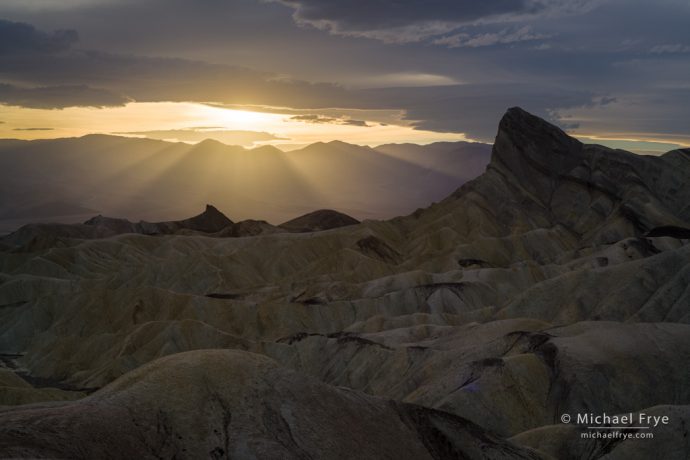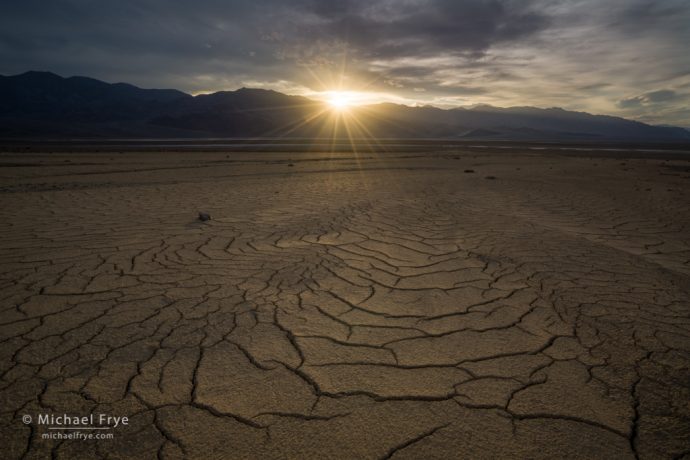We just returned from another workshop in Death Valley. The wind and weather in Death Valley always present challenges, requiring flexibility to adapt to the changing conditions. But this time, just to make things more interesting, Stovepipe Wells lost power during our stay. With high temperatures around 100 we definitely felt the lack of air conditioning. And simple tasks like charging camera batteries became difficult. But California Edison trucked in two generators, so luckily the most serious problems only lasted about 12 hours.
The power outage aside, we actually had very good photo conditions. Some wind just before the workshop cleansed the sand of footprints, and we had clear skies for our first two nights in the dunes. Then some clouds moved in, followed by a big sandstorm on our last night. Typical Death Valley stuff.
I made the photograph above on the third evening of the workshop from below Zabriskie Point. There were a lot of clouds that evening, but a gap in those clouds down near the western horizon gave us hope that the sun could break through and create an interesting sunset. For a brief moment, just before the sun lowered into that gap, we saw some beautiful sunbeams fanning out from underneath the cloud bank. The contrast was extreme, so I bracketed five exposures, each two stops apart, and blended those images with Lightroom’s HDR Merge.
I’ve included another photograph below made before the workshop under similar lighting conditions. We didn’t see any sunbeams that evening, but I was able to capture a sunburst, with light on the mud cracks in the foreground. Again I bracketed five exposures, two stops apart, and blended them with Lightroom’s HDR Merge.
I made many more photographs before and during the workshop, including several from our two beautiful nights in the dunes. I’ll post more images soon.
— Michael Frye
Related Posts: Lunar Eclipse over Death Valley; An Elemental Landscape
Michael Frye is a professional photographer specializing in landscapes and nature. He is the author or principal photographer of The Photographer’s Guide to Yosemite, Yosemite Meditations, Yosemite Meditations for Women, Yosemite Meditations for Adventurers, and Digital Landscape Photography: In the Footsteps of Ansel Adams and the Great Masters. He has also written three eBooks: Light & Land: Landscapes in the Digital Darkroom, Exposure for Outdoor Photography, and Landscapes in Lightroom: The Essential Step-by-Step Guide. Michael has written numerous magazine articles on the art and technique of photography, and his images have been published in over thirty countries around the world. Michael has lived either in or near Yosemite National Park since 1983, currently residing just outside the park in Mariposa, California.











I have yet to visit Death Valley, although I know Russ has been there many times. I am looking forward to times I can spend there with my camera.
Great place with challenging weather. Your shot is one of the very few HDR images that I like. Most everybody goes overboard on them and they look so phony. This one looks quite natural, like I was standing there seeing what you captured.
Thanks Aram. Lightroom’s HDR Merge works well for creating natural-looking HDR images.
You need to go!
Excellent HDR images, as usual. Thank you for sharing. Have you ever used split ND filters to capture image with one shot rather than taking the time to take several time-consuming images to avoid cloud, light and flora movement?
Thanks John. I used graduated ND filters back in my film days, but not since I started using digital cameras. Light and cloud movement is not an issue with auto-bracketing. Flora or water movement could be an issue, but in that case I can usually manually blend two exposures in Photoshop, one for the foreground (where the flora and/or water usually is), and one for the sky. Bracketing and blending gives me much more control of the transitions between light and dark areas than a graduated filter, and one less thing to fiddle with and slow me down in the field.